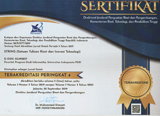Pemanfaatan Aplikasi E-Learning untuk Pembelajaran Materi Umum Berbasis Android
(1) Universitas Indraprasta PGRI
(2) Universitas Indraprasta PGRI
(3) Universitas Indraprasta PGRI
(*) Corresponding Author
Abstract
E-learning application is one of the innovations used in learning. Learning with e-learning applications can provide flexibility in place and time for users. This research aims to develop an e-learning application as a learning medium called Teman belajar. In Teman belajar, there are two actors consisting of admin and users. Admin is an actor who manage all activities in Teman belajar. Users in this research can be divided into two functions, as an exercise maker and exercise seeker. The method used in developing Teman belajar uses the waterfall model. The result of test on Teman belajar in several different smartphones show that the resulting image quality or layout is good and there are no errors found, so it can be concluded that Teman belajar is going well as expected. With Teman belajar application, it hoped that it can fulfill user needs with various of general materials that can be selected as needed.
Keywords
Full Text:
PDFReferences
R. Lailatu, “Konsep E-learning Dan Aplikasinya Pada Lembaga Pendidikan Islam,” An Nur, vol. 1, 2011, doi: 10.24042/atjpi.v8i1.2099.
M. Najieb, “Pengaruh Kualitas Produk terhadap Kepuasan Konsumen Produk Zenius Education [Skripsi],” 2018.
D. Rahamawan, J. N. Mahameruaji, and P. A. J, “The Potential of Youtube As Educational Media for Young People,” Edulib, vol. 8, no. 1, pp. 81–98, 2018, [Online]. Available: https://ejournal.upi.edu/index.php/edulib/article/view/11267/PDF.
Epignosis, “e-learning Concepts, Trends, Applications,” Book, p. 5, 2014, [Online]. Available: https://www.talentlms.com/elearning/elearning-101-jan2014-v1.1.pdf%0Ahttp://www.talentlms.com/elearning/elearning-101-jan2014-v1.1.pdf.
N. S. Hanum, “Keefetifan e-learning sebagai media pembelajaran (studi evaluasi model pembelajaran e-learning SMK Telkom Sandhy Putra Purwokerto),” J. Pendidik. Vokasi, vol. 3, no. 1, pp. 90–102, 2013, doi: 10.21831/jpv.v3i1.1584.
J. Mitchell and M. John, “E-Business and Online Learning: Connections and Opportunities for Vocational Education and Training.,” Aust. Natl. Train. Auth., p. 6, 2003, [Online]. Available: https://www.ncver.edu.au/__data/assets/file/0014/4802/nr1f05.pdf%0Ahttps://login.ezproxy.net.ucf.edu/login?auth=shibb&url=http://search.ebscohost.com/login.aspx?direct=true&db=eric&AN=ED476483&site=ehost-live.
M. Tabrani and E. Pudjiarti, “PENERAPAN METODE WATERFALL PADA SISTEM INFORMASI INVENTORI PT. PANGAN SEHAT SEJAHTERA,” J. Infokar, vol. 1, 2017.
C. Tristianto, “Penggunaan Metode Waterfall untuk Pengembangan Sistem Monitoring dan Evaluasi Pembangunan Pedesaan,” J. Teknol. Inf. ESIT, 2018, doi: 10.1093/nq/182.23.321-a.
R. A. Pascapraharastyan, A. Supriyanto, and P. Sudarmaningtyas, “Rancang Bangun Sistem Informasi Manajemen Arsip Rumah Sakit Bedah Surabaya Berbasis Web,” Sist. Inf., vol. 3, no. 1, pp. 72–77, 2014.
Suendri, “Implementasi Diagram UML (Unified Modelling Language) Pada Perancangan Sistem Informasi Remunerasi Dosen Dengan Database Oracle (Studi Kasus: UIN Sumatera Utara Medan),” J. Ilmu Komput. dan Inform., vol. 3, no. 1, pp. 1–9, 2018, [Online]. Available: http://jurnal.uinsu.ac.id/index.php/algoritma/article/download/3148/187.
D. W. T. Putra and R. Andriani, “Unified Modelling Language (UML) dalam Perancangan Sistem Informasi Permohonan Pembayaran Restitusi SPPD,” J. TeknoIf, vol. 7, no. 1, p. 32, 2019, doi: 10.21063/jtif.2019.v7.1.32-39.
D. Febiharsa, I. M. Sudana, and N. Hudallah, “Uji Fungsionalitas (BlackBox Testing) Sistem Informasi Lembaga Sertifikasi Profesi (SILSP) Batik Dengan AppPerfect Web Test Dan Uji Pengguna,” JOINED J., vol. 1, no. 2, pp. 117–126, 2018, [Online]. Available: http://e-journal.ivet.ac.id/index.php/jiptika/article/view/752.
U. Hanifah, R. Alit, and S. Sugiarto, “Penggunaan Metode Black Box Pada Pengujian Sistem Informasi Surat Keluar Masuk,” SCAN - J. Teknol. Inf. dan Komun., vol. 11, no. 2, pp. 33–40, 2016, [Online]. Available: http://ejournal.upnjatim.ac.id/index.php/scan/article/view/643.
M. S. Mustaqbal, R. F. Firdaus, and H. Rahmadi, “PENGUJIAN APLIKASI MENGGUNAKAN BLACK BOX TESTING BOUNDARY VALUE ANALYSIS (Studi Kasus : Aplikasi Prediksi Kelulusan SNMPTN),” vol. I, no. 3, pp. 31–36, 2015.
W. N. Cholifah, Y. Yulianingsih, and S. M. Sagita, “Pengujian Black Box Testing pada Aplikasi Action & Strategy Berbasis Android dengan Teknologi Phonegap,” STRING (Satuan Tulisan Ris. dan Inov. Teknol., vol. 3, no. 2, p. 206, 2018, doi: 10.30998/string.v3i2.3048.
DOI: http://dx.doi.org/10.30998/string.v5i3.8315
Refbacks
- There are currently no refbacks.
Copyright (c) 2021 Widy Saeful Iman, Mei Lestar, Ni Wayan Parwati S

This work is licensed under a Creative Commons Attribution 4.0 International License.
STRING (Satuan Tulisan Riset dan Inovasi Teknologi) indexed by:

Ciptaan disebarluaskan di bawah Lisensi Creative Commons Atribusi 4.0 Internasional.
View My Stats


 Sertifikat Akreditasi
Sertifikat Akreditasi
















